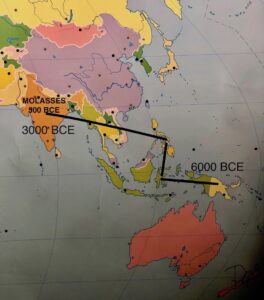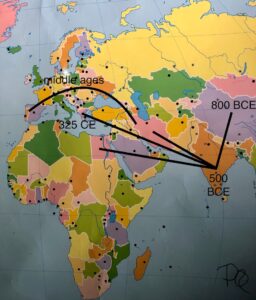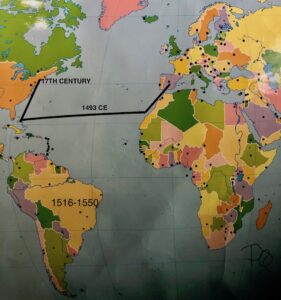Sugar cane and Molasses
Wild sugar cane grew approximately 8,000 years ago in the South Pacific on the tropical island of New Guinea. Through trade, sugar cane traveled to Indonesia and the Philippines and reached India by around 3000 BCE. It is noted that molasses has been used since about 500 BCE in India as they developed a crude technique of evaporating sugar syrup which hardened into a solid called “stone honey.”

Sugar Map 1
India traded sugar cane to Persia and Egypt and by 800 BCE it was introduced to China. Other sources show its introduction to China as early as 1200 BCE from spread through southeast Asia. Alexander the Great returned to Greece from his campaign in India in 325 CE and brought some of this “honey” with him.
After the Crusaders had a taste of sugar during their travels to the Holy Land in the Middle ages, Arabs started to trade it with Europe. With production limited to India and the Middle East, sugar was expensive in Europe, costing about a day’s wages for a small bag.

Sugar Map 2
The first sugar plantations in the Caribbean were established by Christopher Columbus on his second voyage when he brought cuttings of sugar cane from the Spanish-controlled Canary Islands. The Portuguese focused on their sugar plantations in Brazil but proved to be not as successful as the Caribbean Islands.
In the 17th century, importance of sugar control in the western world became more prevalent. England captured Jamaica in 1655, freeing itself of Spain’s imports of sugar, molasses and cacao beans but precipitated a 3 year war with Spain.
Rum
The exact origin of rum is arguable. There is a possibility that distilled sugar cane dates back to India in 1316 CE, when the Sultan of Delhi died. Among his other laws, the Sultan prohibited the distillation of “wine” from sugar cane. There is other evidence that rum was produced in Brazil in the 1620s. However, most credit the origin of rum to the Caribbean Island of Barbados around 1651 and shortly, thereafter, rum became well known in the British American Colonies.

Sugar Map 3
The first rum distillery in the colonies was established on Staten Island in 1664. By 1733, American colonists consumed rum at the rate of 3.75 gallons per year for every man, woman, and child.
Molasses Act of 1733
The Molasses Act of 1733 raised the price of rum, and it imposed heavy duties on the molasses, sugar and rum imported to the colonies from non-British West Indian Islands.
By 1750, Massachusetts had 63 distilleries producing rum made from molasses. They used approximately 1500 hogsheads of molasses per year (1 hogshead = 63-64 gallons), supplied in some cases by slave traders. This “triangular trade” between New England, the African Gold Coast and the West Indies, comprised of molasses from the West Indies being sent to New England, New England rum to Africa and African slaves to the West Indies.
The Sugar Act
In 1763, of 14,000 hogsheads of molasses brought into New England, only 2500 was from British sources and smugglers account for the remainder. The Sugar Act of 1764 replaced the Molasses Act of 1733. Even though the Sugar Act cut in half the tax on molasses imported into British colonies from non-British islands in the West Indies, the British still sent customs officials to the American colonies. These officials forced the colonial governors to enforce the new law and apprehend smugglers. Taxes on molasses, along with many other taxes including the very well-known tea tax, contributed to the American revolution.
Ok enough history, let’s make some rum pancakes!

